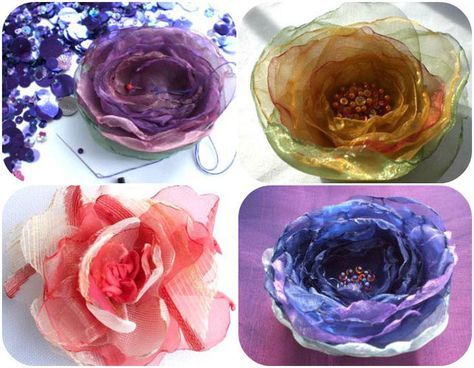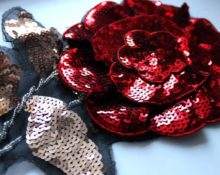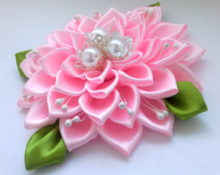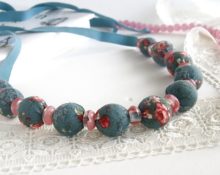 Even the most beautiful dress will sparkle in a new way if you complement it with a fabric flower.
Even the most beautiful dress will sparkle in a new way if you complement it with a fabric flower.
You can wear jewelry in different ways:
with a hair clip, a flower will complement an elegant hairstyle;
if you decorate a bracelet with it, then you won’t be able to take your eyes off your hands;
on a dress it can be a brooch on the chest or hide a belt clasp.
Ways to create a flower step by step
Delicate flower on the dress
As a first experience, a creation made from thin natural fabrics is suitable. The translucent texture will make the flower delicate, the rigidity of the denser fabric will make the petals stable in shape. It is better to choose a medium size for the first flower: fine details require skill, but assembling a large one is the job of experienced flower makers.
 Pattern
Pattern
The best source of inspiration is, of course, nature. Experienced craftsmen create exact copies of natural flowers by first taking patterns from their petals. For a fantasy shape, approximate patterns of petals of three or four sizes are sufficient. These can be individual large petals and a continuous circle of the smallest petals.
 Fabric selection
Fabric selection
Beautiful flowers are obtained from companion fabrics. A denser fabric for the outer large petals is complemented by a translucent center. It is better to choose light fabrics; you can dye the color to match the dress.
 Natural silk fabric molds well, so for the first experiment it is better to choose it. Gelatin or PVA can be used as a coupling agent. The second is used for accessories that are not afraid of moisture. For leaves and green buds, dense green silk is suitable.
Natural silk fabric molds well, so for the first experiment it is better to choose it. Gelatin or PVA can be used as a coupling agent. The second is used for accessories that are not afraid of moisture. For leaves and green buds, dense green silk is suitable.
Petal coloring
It is necessary to paint after treatment with finishing agent. You can use aniline or food dyes. Wet blanks are laid out on the glass. The petals are tinted with a brush, moving from the middle to the outer edge. Since the fabric is wet, the color stretches smoothly and naturally.
 Preparation of materials
Preparation of materials
The molding of flower parts occurs under the influence of heat and pressure. Special bulge attachments are put on a regular soldering iron; the base for bulging is a soft and hard pad. Foam rubber serves as filling in the soft substrate, and a rubber mat in the hard one. We will assemble the flower using PVA glue and thin wire glued at the base of the petals.
 Shaping the petals
Shaping the petals
We give the shape to the petals using special nozzles on a soldering iron. I formed my first flower using a spoon and a kitchen knife. Heated over an open flame, they are not as effective as a soldering iron with a special tool.
Reference! Buying a tool today has become very easy. All you have to do is make a request and the necessary tools are at your disposal.
 We work alternately on a hard and soft pad.After just a few petals you will have a clear understanding of which combination of movements and for which form is most suitable.
We work alternately on a hard and soft pad.After just a few petals you will have a clear understanding of which combination of movements and for which form is most suitable.
Making pistil and stamens
To make stamens, we use chopped thick fishing line; its sections can be dipped in tinted semolina. We form the pestle from cotton wool on a wire and paint it in the desired color.
 Flower core
Flower core
To decorate the core of a fantasy flower, a variety of materials can be used. The following will be used: buttons, beads, seed beads and even feathers.
Second flower
Another flower I love for its simplicity. It always turns out different, the result is unpredictable.
 Fabric selection
Fabric selection
We will make it from ordinary, synthetic organza.. To make it match the fabric of the dress, you can include several petals from a fabric suitable for the dress. We cut the petals a little larger than for the previous flower.
 Petal molding
Petal molding
We clamp the petal with tweezers from the edge where it will be sewn into the middle. Carefully lower it over the candle flame. The edge of the petal melts and curls. The final shape can be achieved by lightly pulling in the desired direction. Just like with gurgles, mastered movements come with a little experience.
 Flower assembly
Flower assembly
First we prepare the middle of the flower. It can be the same as in the first case, or you can embroider a fabric-covered button with mother-of-pearl beads of different shades. We collect the petals from the middle of the flower outward. From small ones we gradually move towards larger ones.

Important! What is the advantage of this simple flower - it is not afraid of bad weather. Without finishing and rare in our area, PVA retains its original shape perfectly, even in bad weather.
 There are a great many types of artificial flowers.These are miniature kanzashi that came to us from Japanese culture. The custom of decorating oneself to protect oneself from evil spirits is very ancient there. In any culture, it is customary to decorate yourself with fresh flowers. But fresh flowers quickly wither, so an alternative made from artificial plants comes to the rescue. The custom quickly takes root and is passed on from generation to generation.
There are a great many types of artificial flowers.These are miniature kanzashi that came to us from Japanese culture. The custom of decorating oneself to protect oneself from evil spirits is very ancient there. In any culture, it is customary to decorate yourself with fresh flowers. But fresh flowers quickly wither, so an alternative made from artificial plants comes to the rescue. The custom quickly takes root and is passed on from generation to generation.

Different flower making techniques
Fabric jewelry is a very ancient accessory. The first appearance dates back to Ancient China before our era. The flowers were made of silk, porcelain and gold. They said about the masters that they see the soul of a flower, which is why their creations are so beautiful. Later in Ancient Greece, artificial flowers were used to carry a reservoir of aromatic oils.
 Dominican monks were the first to make plants from materials soaked in gelatin in the seventeenth century. Since then, fashion has faded and then flared up with renewed vigor. They are always present in wedding and festive clothes.
Dominican monks were the first to make plants from materials soaked in gelatin in the seventeenth century. Since then, fashion has faded and then flared up with renewed vigor. They are always present in wedding and festive clothes.
 Not every outfit goes well with artificial flowers, but every girl has many reasons to wear a dress decorated with an original accessory. This is a continuity of generations and a tribute to beauty, which always has a place in our hectic world.
Not every outfit goes well with artificial flowers, but every girl has many reasons to wear a dress decorated with an original accessory. This is a continuity of generations and a tribute to beauty, which always has a place in our hectic world.


 0
0





